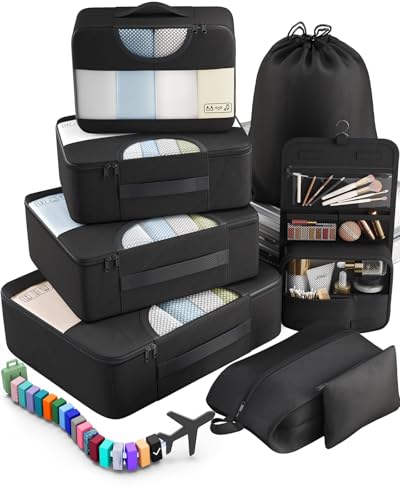In India, they use Type C, D, and M power plugs and outlets. The voltage is 230V, and the frequency is 50Hz.
So, you’ll need a travel adapter in India. Their plugs and outlets are different from the Type A and B ones we use back in the States.
Quick Overview of the Plugs in India:
- Plug type in India: C, D, and M
- Standard voltage: 230V
- Frequency: 50Hz
- Need a travel adapter? Yes, you do need a travel adapter
- Need a voltage converter? Only necessary for specific appliances
- Recommended plug adapter: Vintar Universal Travel Adapter Kit
All details are checked against official power guidelines, IEC standards, and real-world input from travelers who’ve been there recently.
The Only Travel Adapter You’ll Need in India
The wrong adapter can mean slow charging, device damage, or no power at all. We don’t sell travel adapters, but we’ve found the best one for India by looking at voltage, safety, and compatibility. Here’s our top pick:
Recommended Travel Plug Adapter
by 1,000+ travelers on Amazon
Even if you forgot to pack a power adapter, you’re not out of luck. Most places sell them. That said, bringing one from home gives you peace of mind and avoids having to settle for a cheap or incompatible option.
People visiting India frequently also explore Nepal, Sri Lanka, and Bhutan. Always check what kind of travel adapter you’ll need for each country.
Power Outlets in India
In India, they use Type C, D, and M power plugs and outlets.
Type C

Type C outlets have two round prongs and no grounding pin. Type E and F plugs usually fit too, but grounded plugs will need an adapter.
Type D

Type D outlets have three large round prongs in a triangular layout and typically only accept Type D plugs, although Type C plugs might fit loosely and are not recommended for safe use.
Type M

Type M outlets have three large round prongs like Type D but spaced farther apart, designed for high-power appliances, and only accept Type M plugs—Type C may fit, but it’s unsafe and not recommended.
Do You Need a Voltage Converter?
Before plugging in your electronics in India, check the voltage. It’s different from the 120V used in the U.S., so you’ll likely need a converter.
Before heading abroad, always check the power input label on your device. If it reads “100-240V, 50/60 Hz”, it’s designed to run on both 120V and 220-240V without needing a converter. Many smartphones, laptops, and cameras have this capability.

Which Travel Devices May Need a Converter?
Not sure which voltage converter to get? Take a look at the best-rated ones right here.
| Device | Need Converter? | Notes |
|---|---|---|
| Phone | ❌ No (usually) | Most modern phone chargers are dual voltage (100–240V) |
| Laptop | ❌ No (usually) | Check the power brick label for 100–240V |
| Hairdryer | ✅ Yes (often) | High wattage; many models are not dual voltage |
| Electric toothbrush | ⚠️ Check voltage | Some models are 110V only |
| Camera / DSLR | ❌ No (usually) | Most chargers are dual voltage |
| Power bank | ❌ No | Charges via USB, adapter is enough |
| Electric shaver / trimmer | ⚠️ Check voltage | Older or cheaper models may not support 230V |
| Tablet / iPad | ❌ No | All models are dual voltage |
| Portable fan | ✅ Yes (sometimes) | Many models are not compatible with 230V |
| Game console | ⚠️ Check voltage | Newer consoles like PS5 and Xbox are often dual voltage — check to be sure |
| Bluetooth speaker | ❌ No (usually) | Charges via USB |
| E-reader (Kindle, etc.) | ❌ No | USB charging only, no converter needed |
Top Travel Essentials to Pack
With a few key extras, you can avoid a lot of small travel problems. These essentials are smart to bring along.
Digital Luggage Scale
Packing Cubes
Power Bank
More About India
India isn’t just a country—it’s a sensory overload, a living museum, and a full-on adventure all rolled into one. It’s got 1.4 billion people, 22 official languages, and every landscape you can imagine: mountains, deserts, beaches, jungles, and megacities. One day you’re hiking the Himalayas, the next you’re riding a camel through Rajasthan or sipping coconut water in Kerala.
There’s history everywhere. Forts, palaces, ancient temples, and colonial leftovers tell stories that stretch back thousands of years. But India’s also looking forward—its tech scene is booming, cities are expanding fast, and young creatives are redefining what modern India looks like. It’s a country that never stops evolving.
And the food? It’s not just spicy or flavorful—it’s deeply regional and personal. Every state has its own specialties, every home its own recipe. If you’re open-minded and okay with a little beautiful chaos, India will reward you with unforgettable moments, meals, and people. It’s not always easy, but it’s always worth it.
Top places to visit in India: New Delhi, Mumbai, Jaipur, Varanasi, Agra, Goa, Bangalore, Kolkata, Chennai, and Udaipur.




